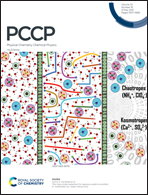Influence of the stacking sequence on layered-chalcogenide properties: first principles investigation of Pb2Bi2Te5†
Abstract
The Pb2Bi2Te5 compound has been reported in the literature with two stacking sequences –Te–Pb–Te–Bi–Te–Bi–Te–Pb–Te– and –Te–Bi–Te–Pb–Te–Pb–Te–Bi–Te– labelled in this work as A and B, respectively. The electronic and the thermoelectric properties of the Pb2Bi2Te5 compound with the 2 different stacking sequences have been determined from a series of first principles calculations using density functional theory (DFT). The related compounds PbTe and Bi2Te3 have also been investigated for comparison. Different exchange–correlation functionals have been tested, without spin–orbit coupling, which has been found to have important effects. The elastic moduli, dielectric constants, Born effective charges, and phonon dispersion within the quasi-harmonic approximation have also been calculated and based on these calculations results, the thermal conductivity has been determined by solving the Boltzmann transport equation. Additionally, the QTAIM theory was employed to explain the differences in the properties of the 2 stackings. The most interesting compound for thermoelectric applications has been found to be Pb2Bi2Te5 with the stacking B sequence. The highest zT values have been found to be 4.02 in the a-axis direction and 2.26 in the c-axis one.

- This article is part of the themed collection: 2021 PCCP HOT Articles


 Please wait while we load your content...
Please wait while we load your content...